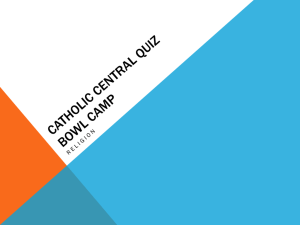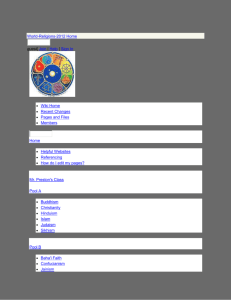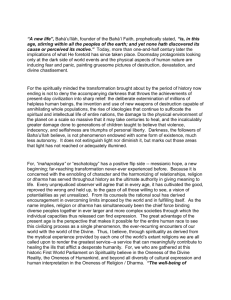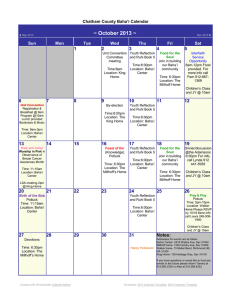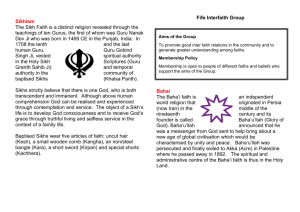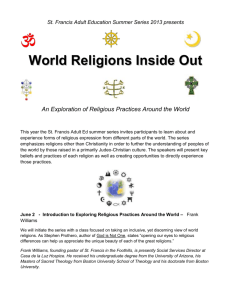The Baha'i Faith
advertisement
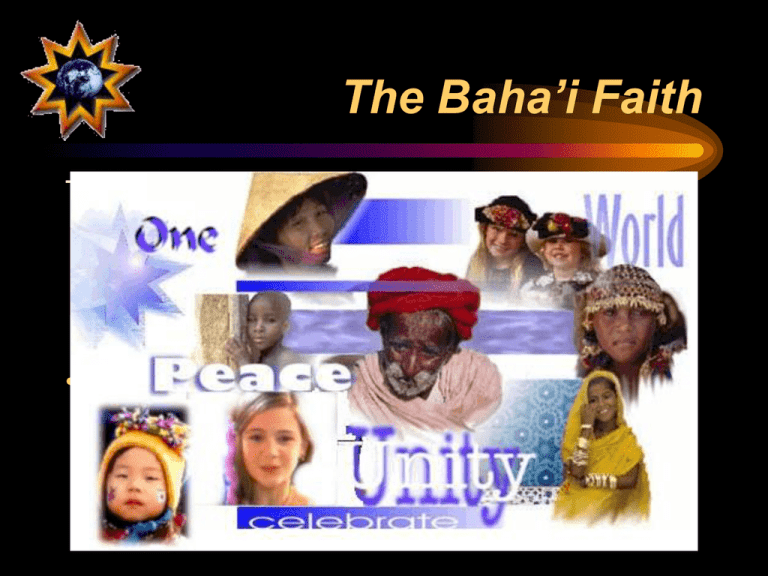
The Baha’i Faith This youngest of the world’s major religions teaches unity… – of God – of humanity – of all religions • A “universal” religion of 5 – 6 million followers in over 200 countries and principalities – densest populations of Baha’is are found in Iran, India, areas of Africa, North and South America How did this new faith begin? • Grew out of Shi’ite Islam in 19th century Persia (Iran) • 1844: declaration of The Bab (“gate”) as a prophet, proclaiming the coming of a new messenger of God (b. 1819, d. 1850) • 1863: declaration of Baha’u’llah (the “Glory of God”) as the fulfillment of this prophecy (b. 1817, d. 1892) Progressive Revelation Revelation from God is on-going: • God has communicated with each culture throughout the ages through prophets • Nine “manifestations” of God: Abraham, Krishna, Moses, Zoroaster, Buddha, Jesus, Muhammad, The Bab, Baha’u’llah and more to come as humanity continues to mature • Each religion is unique for each time and place, yet they are all one - each a continuation and advancement on the one before What did Baha’u’llah teach? • A new revelation for the new global society of all humanity under one God: “The earth is one country and mankind its citizens” • Spiritual teachings of all religions are universal and eternal • Social teachings must be updated as humanity matures… New social teachings: • Racial unity • World peace: encourage development of a universal language (by which all humanity can communicate with one another) and one world government • Gender equality (women are full equals to men): – Stress higher education for women as well as men • Harmony of science and religion • Work for social and economic development, especially in third world countries • As in all religions, family values remain strong: however, encourage interracial and international marriage (to further unify humanity); interfaith marriage also not an issue Early Leadership • Baha’u’llah – taught from life-long house arrest in Acre, Palestine (now near Haifa, in Israel) • His son, Abdu’l - Baha (b. 1844, d. 1921) – spread the new faith, through writings and travel, throughout the world to Europe, the Americas, India, Africa… • Abdu’l - Baha’s grandson, Shoghi Effendi (1897 – 1957) wrote many basic books on the Baha’i Faith and restructured its organization to what it is today Sacred Writings • The only religion whose sacred texts were written by the hand of its prophet during his lifetime • Many books and letters revealed through and written by Baha’u’llah. Among the more important: – Kitab-i-aqdas (“The Most Holy Book” – basic rules and ordinances of the faith) – Kitáb-i-Iqán (“The Book of Certitude”) – Hidden Words (a collection of prayers) – Gleanings (from the writings of Baha’u’llah) – Seven Valleys (a mystical, metaphorical text) • Other important writings by Abdu’l – Baha and Shoghi Effendi Organizational Structure • 1963: The Universal House of Justice – headquarters in Haifa, Israel, headed by nine officials elected every five years by and from among Baha’is world-wide • National and local “spiritual assemblies,” each comprised of nine elected leaders • “Local Baha’i communities” of at least nine adult Baha’is within a given geographic locale, gather regularly for study, discussion, and spiritual renewal Sacred Places New Delhi, India • Shrine of the Bab in Haifa, Israel • Shrine of Baha’u’llah (his burial site) and surrounding gardens in Acre, Israel • Other locations related to the lives of the Bab, Baha’u’llah, and Abdu’l - Baha • Seven Baha’i Temples worldwide (one on each continent): Western Samoa Uganda, Africa Chicago, USA Sydney, Australia Frankfurt, Germany Panama City, Panama The Baha’i Calendar A new calendar for a new age: • 19 months of 19 days each (361 days) • Plus 4 or 5 “intercalary days” (Feb 26 – March 1) • Last month, March 2 – 20, a month of fasting, sun-up to sun-down • The new year (Naw Ruz) begins on March 21, the spring equinox Baha’is observe nine annual holy days… Holy Days • Naw-Ruz (Persian New Year) – March 21 • 12 days of Ridvan (commemorating the declaration of Baha’u’llah) April 21 – May 2 (esp. 1st, 9th, 12th days) • Declaration of the Bab – May 23 • Ascension of Bahá'u'lláh - May 29 • Martyrdom of The Báb – July 9 • Birth of The Báb - October 20 • Birth of Bahá'u'lláh – November 12 • Day of Covenant – November 26 • Ascension of Abdu’l – Baha – November 28 Work is suspended, some fast days, community gatherings for observance Practices No churches, no clergy; led by lay leaders locally, Baha’is meet mainly in homes of members for: • “Feast days” on the first of each 19 day month – worship consists of readings from sacred writings of many religions, discussion of community business, and socializing • “Deepenings” for group study of sacred texts and related religious writings • “Firesides” for open discussion of Baha’i teachings – often involving interested and curious non-Baha’is Use of consultation and consensus for group decision making Web Resources • The Baha’i World: “Official international site for the Baha’i Faith… a comprehensive, informative and attractive web site designed for the individual wishing to acquire a basic, introductory view of the world's newest religion” http://www.bahai.org/ • The Baha’i Faith: “Official US site for the Baha’i Faith” http://www.us.bahai.org/ • http://www.bahai.com/welcome.htm: maintained by an individual Baha’i, not an “official” site but rich in resources, including links to other sites. Includes the online version of the Baha’i Magazine: http://www.bahai.com/thebahais/index.htm

